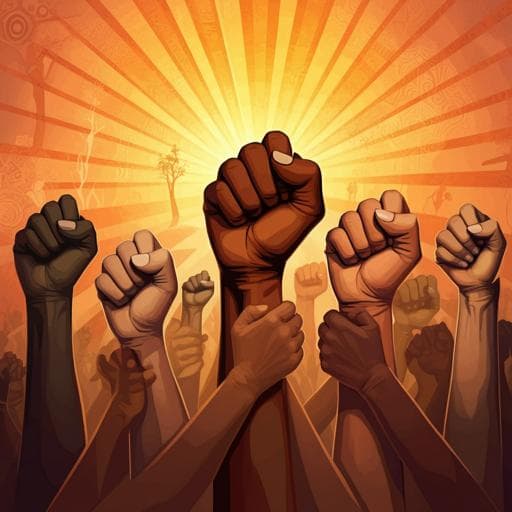
Political Science
Taking a Longer Historical View of America's Renaming Moment: The Role of Black Onomastic Activism within the Student Nonviolent Coordinating Committee (SNCC)
D. H. Alderman, J. Inwood, et al.
This engaging research by Derek H. Alderman, Joshua Inwood, and Katrina Stack delves into the impactful history of Black naming activism in the USA, exploring how the Student Nonviolent Coordinating Committee used renaming as a powerful political tool during the Civil Rights Movement. Discover the transformative potential of onomastic tactics that went beyond mere symbolism to reshape identities and assert rights.
~3 min • Beginner • English
Introduction
The paper situates the United States within a broader global “renaming moment,” wherein names on streets, schools, bases, brands, mascots, and species are being contested and changed due to their associations with racism, settler colonialism, slavery, and patriarchy. Black communities have been central to these onomastic campaigns, which challenge harmful nomenclature and advance new practices that recognize Black agency and history. Public debate ranges from conservative resistance and progressive skepticism (e.g., charges of performativity) to activist arguments that renaming challenges structures and atmospheres of inequality and can catalyze wider justice claims.
Against portrayals of renaming as brand new, the authors argue for taking a “longer view” of Black naming politics and practice. They draw on Black geographies and McKittrick’s concept of Black livingness to frame naming as a long-standing arena of struggle and self-determination. The paper’s purpose is twofold: (1) to recover a racial genealogy of naming activism in the U.S., and (2) to illuminate how SNCC incorporated onomastic tactics into its grassroots civil rights praxis, thereby expanding what counts as activism and who is recognized as an activist beyond canonized narratives. The central research thrust asks how naming and renaming operated tactically within SNCC’s organizing to gather counter-intelligence, build subaltern infrastructures, and remake places and affective atmospheres under white supremacy, and what this implies for contemporary renaming efforts.
Literature Review
The paper integrates critical toponymies (critical place naming studies) and Black geographies. Critical toponymies conceptualizes naming as a political technology of power implicated in ordering, contesting, and redistributing identity, resources, and rights, emphasizing both elite and marginalized groups as toponymic actors. Black geographies centers Black agency, humanity, and creativity—“Black livingness” (McKittrick)—and highlights naming as storytelling that asserts counter-narratives and liberation.
Methodologically, the authors draw on Geertz’s thick description to uncover the worldviews, power relations, and lived realities enacted through naming. They historicize Black onomastic practice across eras: protests against naming segregated institutions for enslavers (e.g., Indianapolis’s Crispus Attucks High School in the 1920s), widespread MLK street renamings since 1968 (nearly 1000), intentional Black settlements (maroon communities; postbellum towns like Africatown), and the Green Book’s mapping of Black counter-public spaces and named establishments. These cases demonstrate that contemporary renaming continues a long tradition of Black onomastic activism embedded in place-making, counter-storytelling, and resistance.
The review also addresses co-optation risks (neoliberal multiculturalism), critiques of performativity, and affective dimensions of names. It positions naming within broader assemblages of people, places, technologies, and discourses, arguing that efficacy arises from these relations rather than names alone.
Methodology
The study employs thick description, an interpretive approach that contextualizes naming within the sociopolitical worlds of actors. The authors synthesize archival and digital sources from multiple repositories: the Freedom Summer Digital Collection (Wisconsin Historical Society), NYPL Schomburg Center, NYU Tamiment Library & Wagner Labor Archives, Martin Luther King Jr. Library and Archives (Atlanta), and libraries at Stanford and UC Berkeley. Online sources include the SNCC Digital Gateway, SNCC Legacy Project, and Civil Rights Movement Archive.
Analytically, the paper reconstructs and interprets SNCC’s onomastic tactics through selected cases that reveal how naming functioned tactically within SNCC’s organizing assemblage (communications/data praxis, transportation/mobility, and affective/place-making strategies). The authors note limitations in archival documentation of naming rationales and adopt an anti-racist ethical stance acknowledging their positionality as white scholars engaging with Black struggles and lived theories.
The empirical strategy is illustrative rather than exhaustive: three cases—coded surnames in the WATS phone system; the Sojourner Motor Fleet; and freedom-naming (e.g., Freedom houses, schools, singers)—are used to demonstrate how naming was mobilized within SNCC’s broader praxis.
Key Findings
- SNCC’s coded surnames and WATS line: To gather and protect counter-intelligence on racist violence and activism, SNCC’s Communications Department (Julian Bond and Mary King) established a WATS (Wide Area Telephone Service) line in 1963 and used coded surnames based on tree names (e.g., “John Chestnut,” “John Maple,” “John Pine”) to route calls and reduce costs while evading surveillance and sabotage by local operators aligned with white supremacists. This onomastic tactic supported the creation of WATS Reports that documented incidents and protests, advancing epistemic justice and enabling rapid, life-saving communication.
- Sojourner Motor Fleet and subaltern mobility: SNCC named its transportation fleet (60+ automobiles) after Sojourner Truth and later established the Sojourner Truth Garage (by 1965). The fleet enhanced safe mobility for organizers on dangerous rural roads, with some vehicles modified for speed to evade hostile law enforcement and vigilantes. The naming honored Black women’s leadership—especially Ruby Doris Smith Robinson, who established and managed the fleet—and linked mobility to Black history and feminist praxis. The case highlights both commemorative function and practical mobilization.
- Freedom naming and affective place-making: SNCC widely applied “Freedom” to institutions and practices (Freedom Schools, libraries, songs, parties, farms, Alley, and especially Freedom houses). Freedom Schools in Mississippi (41 sites) taught ~2,500 students in summer 1964, fostering critical civic education. The Freedom Singers traveled ~50,000 miles in 1963 to fundraise, educate, and elevate morale. Freedom houses—both rented sites and community homes—served as integrated organizing hubs and safe havens; some were defended by armed sentries. During Freedom Summer 1964, ~70 homes/community centers were bombed and 35 churches burned in Mississippi over 10 weeks. Freedom naming reshaped affective atmospheres (hope, solidarity) and materially reconfigured places amid racial terror.
- Broader historical context: The paper situates these tactics within longer Black onomastic activism, including almost 1,000 MLK street renamings and iconic counter-public spaces from the Green Book era. It notes persistent commemorative inequities: e.g., one road and four public schools named for Ella Baker, two streets and two schools for Fannie Lou Hamer, and none for Ruby Doris Smith Robinson, compared to the extensive commemoration of Martin Luther King Jr.
Overall finding: Naming was an actionable tactic within SNCC’s assemblage of practices; its efficacy emerged when names were mobilized alongside people, technologies, places, and political objectives. Renaming alone is insufficient for liberation; it must be linked to material, organizational, and affective strategies of change.
Discussion
The findings demonstrate that SNCC’s onomastic practices were integral to its grassroots, participatory democratic organizing. Naming functioned as: (1) protective and strategic infrastructure in counter-intelligence (coded surnames + WATS); (2) a vehicle for subaltern mobility and safety (Sojourner Motor Fleet), honoring Black women’s leadership and embedding Black historical consciousness; and (3) a means of affective and material place-making (Freedom houses, schools, singers) that reshaped the atmospheres and spaces of struggle. These cases answer the research aim by evidencing how naming operated tactically within SNCC’s broader assemblage, rather than as mere symbolism.
Theoretically, the study advances a Black politics of naming anchored in Black livingness—naming as counter-storytelling, identity affirmation, and world-making amidst white supremacy. It reframes civil rights activism beyond spectacular protests to include communication systems, transportation infrastructures, domestic spaces, and cultural production. The work underscores that onomastic reform can catalyze public knowledge, solidarity, and safety but must be connected to broader practices to effect substantive change. This historical genealogy informs contemporary renaming debates, cautioning against performative or co-opted reforms and urging linkage to material equity and procedural justice.
Conclusion
The paper contributes a historically grounded account of Black onomastic activism, centering SNCC to show how naming was tactically mobilized within communication, mobility, and place-making strategies. It expands the canon of civil rights memory by recognizing overlooked actors (e.g., women leaders like Ruby Doris Smith Robinson), infrastructures (WATS, motor fleet), and domestic spaces (Freedom houses) as sites of activism. By articulating naming as part of an assemblage, the authors argue that renaming alone is not liberation; efficacy arises when names are linked to material practices, political organizing, and affective transformations.
Policy directions include: (1) respecting and supporting grassroots naming campaigns by marginalized communities, avoiding dismissals of renaming as merely symbolic; (2) ensuring top-down renaming is materially accountable to and co-governed with impacted communities through inclusive, just procedures; and (3) connecting renaming to broader redistributive and reparative actions that restructure opportunities, rights, and recognition. Future research should further document underexplored onomastic practices across movements, deepen archival recovery of naming decisions, and evaluate how naming reforms are assembled with material justice initiatives.
Limitations
- Scope: The study offers illustrative cases rather than an exhaustive catalog of SNCC’s onomastic practices; many naming moments remain undocumented or underanalyzed.
- Archival constraints: Detailed rationales for naming decisions are often sparse in SNCC records, which prioritized documenting core struggles (voting rights, desegregation, education, survival under violence), leading to partial reconstructions.
- Positionality: The authors acknowledge limits as white scholars interpreting racialized naming struggles, adopting an anti-racist ethics and recognizing the primacy of lived theories from marginalized communities.
- Generalizability: Findings are historically and contextually specific to SNCC and the Civil Rights Movement; transferability requires sensitivity to differing social, spatial, and political conditions.
Related Publications
Explore these studies to deepen your understanding of the subject.







